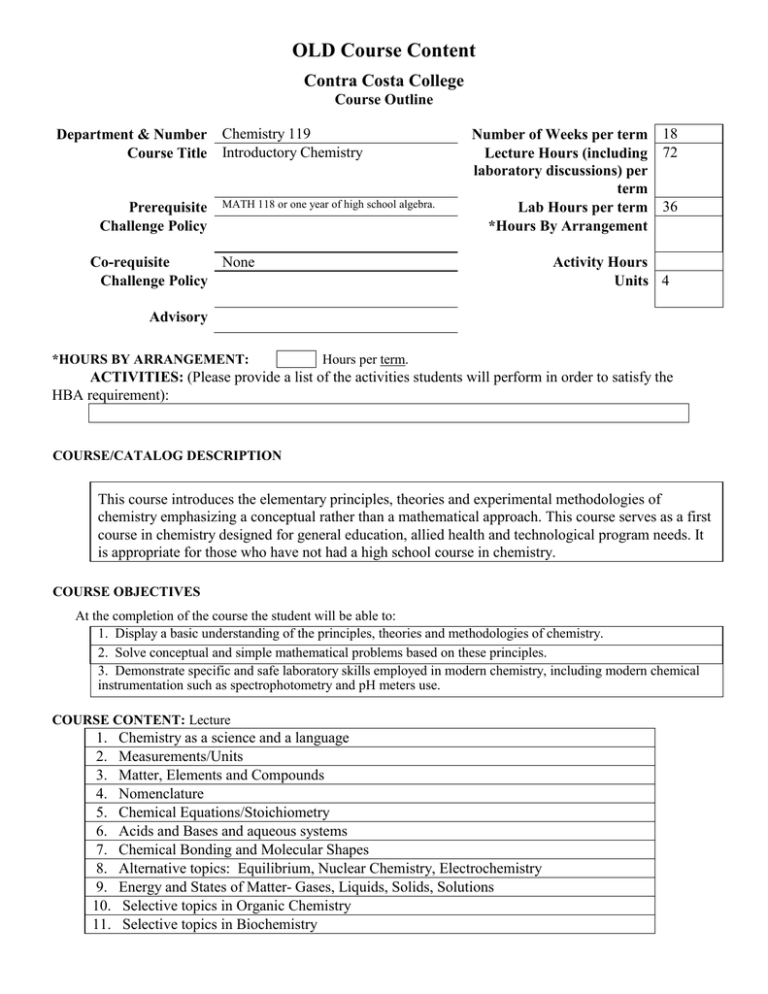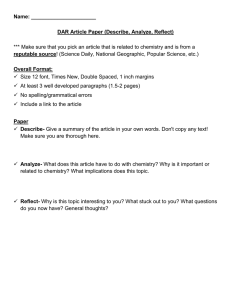
OLD Course Content
Contra Costa College
Course Outline
Department & Number Chemistry 119
Course Title Introductory Chemistry
Prerequisite
Challenge Policy
MATH 118 or one year of high school algebra.
Number of Weeks per term 18
Lecture Hours (including 72
laboratory discussions) per
term
Lab Hours per term 36
*Hours By Arrangement
None
Co-requisite
Challenge Policy
Activity Hours
Units 4
Advisory
*HOURS BY ARRANGEMENT:
Hours per term.
ACTIVITIES: (Please provide a list of the activities students will perform in order to satisfy the
HBA requirement):
COURSE/CATALOG DESCRIPTION
This course introduces the elementary principles, theories and experimental methodologies of
chemistry emphasizing a conceptual rather than a mathematical approach. This course serves as a first
course in chemistry designed for general education, allied health and technological program needs. It
is appropriate for those who have not had a high school course in chemistry.
COURSE OBJECTIVES
At the completion of the course the student will be able to:
1. Display a basic understanding of the principles, theories and methodologies of chemistry.
2. Solve conceptual and simple mathematical problems based on these principles.
3. Demonstrate specific and safe laboratory skills employed in modern chemistry, including modern chemical
instrumentation such as spectrophotometry and pH meters use.
COURSE CONTENT: Lecture
1.
2.
3.
4.
5.
6.
7.
8.
9.
10.
11.
Chemistry as a science and a language
Measurements/Units
Matter, Elements and Compounds
Nomenclature
Chemical Equations/Stoichiometry
Acids and Bases and aqueous systems
Chemical Bonding and Molecular Shapes
Alternative topics: Equilibrium, Nuclear Chemistry, Electrochemistry
Energy and States of Matter- Gases, Liquids, Solids, Solutions
Selective topics in Organic Chemistry
Selective topics in Biochemistry
COURSE CONTENT: Laboratory Experiment Details
1. Laboratory Safety and Equipment
2. Density Determination of Solids and Liquids
3. Separating Mixture Using Filtration and Evaporation
4. Exploring and Categorizing Types of Chemical Reactions
5. Nomenclature of Inorganic Compounds
6. Identification of Common Substances
7. Exploring and Categorizing Electrolytes
8. Identifying Organic Functional Groups by Reactivity
9. Using FTIR to Identify Organic Compounds
10. Moles, Molecules and Atoms Calculations
11. Aspirin Synthesis
12.
13.
14.
15.
16.
Solubility of Common Substances
Titration of Vinegar
Colorimetric Determination of Protein in Beer
Determination of pH using meters and indicators
Polymer formation making superballs
METHODS OF INSTRUCTION
1. Lectures/Discussion/Demonstrations. Audio and Visual.
2. Classroom discussion and problem solving workshop sessions
3.Laboratory and web-based exercises and electronic homework
Other comments: Students are encouraged to work on their own and in study groups to solve exercises from
the text. To aid in preparation for exams and quizzes, examples from previous years are occasionally made
available. Answer keys are posted after exams and quizzes. Students are encouraged to keep track of problems
that give particular difficulty, and to bring their questions up in class or in office hours.
INSTRUCTIONAL MATERIALS
LectureText Title:
Introductory Chemistry
Author:
Zumdahl & Decoste
Publisher:
Brooks /Cole Cengage Learning
Edition/Date:
Seventh Edition, 2011
NOTES: To be UC transferable, the text must be dated within the last 5 years OR a statement of justification
for a text beyond the last 5 years must be included. There are numerous other, equivalent Introductory
Chemistry textbooks and electronic books which could be used for Chemistry 119. A partial list of choices
would include:
Tro, Introductory Chemistry, Pearson/Prentice Hall.
Cracolice & Peter, Introductory Chemistry, Brooks/Cole Cengage Learning.
Stoker, Introduction to Chemical Principles, Pearson/Prentice Hall.
Russo & Silver, Introductory Chemistry, Pearson/Prentice Hall.
Lab Manual Title:
Laboratory Manual for Introductory Chemistry, Chemistry 119
Author:
Dang
Publisher:
Contra Costa College Bookstore
Edition/Date:
2013
Other Materials:
Calculator
Safety goggles
Subscription to On-line Web Learning (OWL)
COURSE EXPECTATIONS (Use applicable expectations)
Outside of Class Weekly Assignments
Weekly Reading Assignments
Weekly Writing Assignments
Weekly Problems
Lab or Software Application Assignments
Other Performance Assignments
Hours per week
2
1
3
2
STUDENT EVALUATION: (Show approximate percentage breakdown for evaluation instruments)
20
40
20
20
%
%
%
%
Quizzes and/or homework
Midterm exams
Laboratory work and reports
Final exam
GRADING POLICY (Choose LG, CR/NC, or SC)
Letter Grade
90% - 100% = A
80% - 89% = B
Pass / No Pass
70% and above = Pass
Below 70% = No Pass
70% - 79% = C
60% - 69% = D
Below 60% = F
Prepared by: Thuy Dang, PhD
Date: October, 2013
X
Student Choice
90% - 100% = A
80% - 89% = B
70% - 79% = C
60% - 69% = D
Below 60% = F
or
70% and above =
Pass
Below 70% = No
Pass




